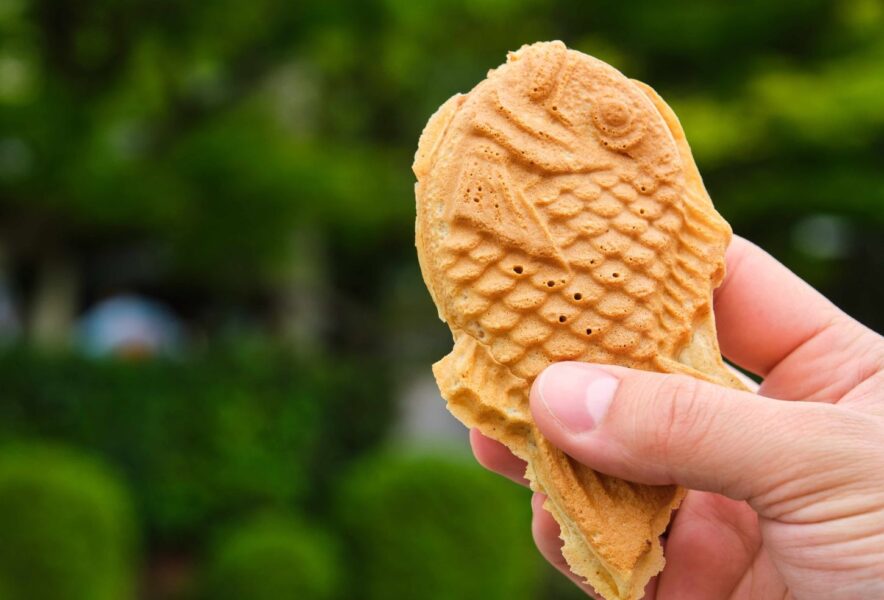- What is Taiyaki? The History of Japan’s Beloved Fish-Shaped Pastry
- Popular Taiyaki Fillings: From Anko to Custard
- Tokyo’s Three Best Taiyaki Shops: Naniwaya Sohonten, Wakaba, and Yanagiya
- How Taiyaki is Made: The Perfect Combination of Crispy and Soft
- Unique Taiyaki Variations: Modern Twists on a Classic Treat
What is Taiyaki? The History of Japan’s Beloved Fish-Shaped Pastry
Taiyaki is a traditional Japanese pastry shaped like a fish, typically filled with sweet anko (red bean paste). The origin of taiyaki dates back to the Meiji era, when it was first created in Tokyo as an affordable snack. The fish shape was chosen because tai (sea bream) is considered a symbol of good fortune in Japan, making taiyaki a festive and lucky treat.
Today, taiyaki is beloved not only in Tokyo but across Japan, often enjoyed during festivals or sold at street stalls. Its popularity has even spread internationally, and visitors to Japan often seek out this unique, fish-shaped snack to taste a piece of history.
Popular Taiyaki Fillings: From Anko to Custard
While anko remains the most traditional filling, taiyaki has evolved to feature a variety of flavors. Here are some popular options you can find today:
- Koshi-an (Smooth Red Bean Paste): The original filling, made from finely mashed sweetened azuki beans. Its smooth texture makes it a perfect match for the crispy exterior of the taiyaki.
- Tsubu-an (Chunky Red Bean Paste): This filling leaves bits of the azuki beans intact, giving it a heartier, more textured bite.
- Custard Cream: A popular alternative to anko, custard-filled taiyaki offers a rich, creamy sweetness that is especially popular with younger generations.
- Chocolate: Some shops offer taiyaki filled with melted chocolate, creating a fusion of traditional and modern flavors.
- Savory Fillings: Recently, shops have started experimenting with savory fillings like cheese, sausage, or even curry, expanding the taiyaki experience beyond just dessert.
Tokyo’s Three Best Taiyaki Shops: Naniwaya Sohonten, Wakaba, and Yanagiya
Tokyo is home to many famous taiyaki shops, but three stand out as the most iconic. These shops have been serving this delicious treat for decades, making them must-visit destinations for taiyaki lovers.
Naniwaya Sohonten (浪花家総本店)
Established in 1909, Naniwaya Sohonten is widely regarded as the birthplace of taiyaki. Located in Azabu, this shop has been serving taiyaki for over a century and continues to attract customers from all over Japan. The thin, crispy crust is perfectly paired with a generous amount of smooth, sweet koshi-an.
What sets Naniwaya apart is their dedication to traditional methods. The taiyaki is cooked one by one in cast-iron molds, giving each piece the perfect balance of crispiness on the outside and softness on the inside.
Address:
1 Chome-8-14 Azabujuban, Minato City, Tokyo 106-0045
Google Maps:
Naniwaya Sohonten
Taiyaki Wakaba (たいやき わかば)
Located near Yotsuya, Taiyaki Wakaba has been a local favorite since its establishment in 1953. Unlike other taiyaki shops, Wakaba uses a slightly thicker dough, giving the taiyaki a more substantial bite while maintaining a crispy exterior. The filling is tsubu-an, providing a textured sweetness that perfectly complements the slightly chewy crust.
Wakaba is a cozy little shop where you can enjoy your taiyaki freshly made, and the friendly atmosphere adds to the experience. Locals often form lines here, especially during weekends, proving that the quality is consistently high.
Address:
1 Chome-10 Wakaba, Shinjuku City, Tokyo 160-0011
Google Maps:
Taiyaki Wakaba
Yanagiya (柳屋)
Tucked away in a quiet street of Ningyocho, Yanagiya has been making taiyaki the traditional way since 1916. The shop is famous for its crispy exterior and soft, moderately sweet anko filling. The taiyaki here are made to order, ensuring that each one is piping hot and perfectly fresh when served.
Yanagiya’s taiyaki is known for being a little less sweet compared to other shops, making it a favorite among those who prefer a more subtle, refined flavor. The dough is delicate, and the taiyaki are slightly smaller than average, but the craftsmanship that goes into each piece is evident.
Address:
1 Chome-10-6 Nihonbashi Ningyocho, Chuo City, Tokyo 103-0013
Google Maps:
Yanagiya
How Taiyaki is Made: The Perfect Combination of Crispy and Soft
The art of making taiyaki is deceptively simple. First, a fish-shaped iron mold is heated, and a thin layer of batter (typically made from flour, eggs, sugar, and water) is poured into the mold. The filling—whether it’s anko, custard, or another choice—is added, and then more batter is poured on top to seal it in.
The mold is then closed, and the taiyaki is cooked over an open flame, flipped repeatedly to ensure even cooking. The result is a crispy exterior that contrasts beautifully with the soft, flavorful filling inside. The key to perfect taiyaki lies in achieving the right balance between crispiness and softness, a skill honed by taiyaki artisans over many years.
Unique Taiyaki Variations: Modern Twists on a Classic Treat
While traditional taiyaki is filled with anko or custard, modern versions have introduced exciting new flavors and styles. Some shops offer matcha-flavored batter or fillings like sweet potato, cream cheese, and even ice cream. These new takes on the classic taiyaki are especially popular with younger generations and tourists looking for something a little different.
In recent years, taiyaki has also gone global, with international versions popping up in places like New York and Paris. These adaptations often feature new fillings like Nutella, peanut butter, or mochi, further expanding the delicious possibilities of this iconic Japanese snack.

Comment